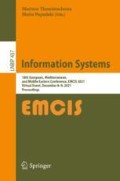Abstract
Higher education institutions have a big impact on the future of skills supplied on the labour market. It means that depending on the changes in labour market, higher education institutions are making changes to fields of study or adding new ones to fulfil the demand on labour market. The significant changes on labour market caused by digital transformation, resulted in new jobs and new skills. Because of the necessity of computer skills, general universities started to offer various courses on IT, including computer science that was originally offered by technical universities. It is also possible to have selected medical studies not only at medical universities but also in private colleges, e.g., nursing studies. As a result, the current classification of higher education institutions used in official statistics can be revised. The paper shows the experimental work on the use of machine learning methods to classify and cluster higher education institutions in Poland. Different attributes were used to classify the type of institution, including fields of studies, programme orientation and others. The aim of the paper was also to evaluate various machine learning methods in the process of classifying or clustering and validating the associated types of higher education institutions.
Access this chapter
Tax calculation will be finalised at checkout
Purchases are for personal use only
References
Woźnicki, J.: Deregulacja w systemie szkolnictwa wyższego. Program rozwoju szkolnictwa wyższego do 2020 r. Część V, FRP, KRASP, Warszawa (2015)
POL-on. Higher education institutions (2021). https://polon.nauka.gov.pl/opi/aa/rejestry/szkolnictwo?execution=e7s1. Accessed 20 Oct 2021
Antonowicz, D.: Stopniowe różnicowanie systemu szkolnictwa wyższego i jego konsekwencje. Seria Raportów Centrum Studiów nad Polityką Publiczną UAM. Poznań (2019)
Act of July 20, 2018, Law on Higher Education and Science (2018)
Higher education schools and their finances, Statistics Poland (2019)
Jalote, P., Jain, B.N., Sopory, S.: Classification for research universities in India. High. Educ. 79(2), 225–241 (2019). https://doi.org/10.1007/s10734-019-00406-3
Shin, J.C.: Classifying higher education institutions in Korea: a performance-based approach. High. Educ. 57, 247–266 (2009). https://doi.org/10.1007/s10734-008-9150-4
Hermanowicz, J.C.: Classifying universities and their departments: a social world perspective. J. High. Educ. 76(1), 26–55 (2005). https://doi.org/10.1353/jhe.2005.0005
Van Vught, F.A., Kaiser, F., File, J.M., Gaethgens, C., Westerheijden, D.F.: U-map: the European classification of higher education institutions. Center for Higher Education Policy Studies – CHEPS, Enschede (2010)
Ziegele, F.: Classification of higher education institutions: the European case. Pensamiento educativo. Rev. Invest. Educ. Latinoamericana 50(1), 76–95 (2013). http://dx.doi.org/10.7764/PEL.50.1.2013.7
Szadkowski, K.: Globalne rankingi uniwersytetów a długoterminowa strategia wzmacniania pozycji polskich uczelni. Seria Raportów Centrum Studiów nad Polityką Publiczną UAM, Poznań (2019)
Kumar, R., Pattnaik, P.K.: Graph Theory. Laxmi Publications Pvt Ltd. (2018)
Razmjooy, N., Estrela, V., Loschi, H.: A study of metaheuristic-based neural networks for image segmentation purposes. In: Memon, Q., Khoja, S. (eds.) Data Science. Theory, Analysis, and Applications. CRC Press, Taylor & Francis Group (2020)
Alloghani, M., Al-Jumeily, D., Mustafina, J., Hussain, A., Aljaaf, A.J.: A Systematic review of supervised and unsupervised machine learning algorithms for data science. In: Berry, M.W., Mohamed, A., Wah Yap B. (eds.) Supervised and Unsupervised Learning for Data Science. Unsupervised and Semi-supervised Learning, pp. 3–21. Springer, Cham (2020). https://doi.org/10.1007/978-3-030-22475-2_1
Albalate, A., Minker, W.: Semi-Supervised and Unsupervised Machine Learning: Novel Strategies, pp. 1–320. Wiley (2011)
Hu, W., Singh, R.R.P., Scalettar, R.T.: Discovering phases, phase transitions, and crossovers through unsupervised machine learning: a critical examination. Phys. Rev. E. 95(6), 14 (2017). https://doi.org/10.1103/PhysRevE.95.062122
Nahili, W., Rezeg, K., Kazar, O.: A new corpus-based convolutional neural network for big data text analytics. Journal of Intelligence Studies in Business 9(2), 59–71 (2019). https://doi.org/10.37380/jisib.v9i2.469
Ramesh, V.P., Baskaran, P., Krishnamoorthy, A., Damodaran, D., Sadasivam, P.: Back propagation neural network based big data analytics for a stock market challenge. Commun. Stat.: Theory Methods 48(14), 3622–3642 (2019). https://doi.org/10.1080/03610926.2018.1478103
Chong, A.Y.L., Ch’ng, E., Liu, M.J., Li, B.: Predicting consumer product demands via big data: the roles of online promotional marketing and online reviews. Int. J. Prod. Res. 55(17), 5142–5156 (2017). https://doi.org/10.1080/00207543.2015.1066519
Paliouras, G., Papatheodorou, C., Karkaletsis, V., Spyropoulos, C.D.: Discovering user communities on the Internet using unsupervised machine learning techniques. Interact. Comput. 14(6), 761–791 (2002). https://doi.org/10.1016/S0953-5438(02)00015-2
Maślankowski, J.: Towards de-duplication framework in big data analysis: a case study. In: Wrycza, S. (ed.) SIGSAND/PLAIS 2016. LNBIP, vol. 264, pp. 104–113. Springer, Cham (2016). https://doi.org/10.1007/978-3-319-46642-2_7
Author information
Authors and Affiliations
Corresponding author
Editor information
Editors and Affiliations
Rights and permissions
Copyright information
© 2022 Springer Nature Switzerland AG
About this paper
Cite this paper
Maślankowski, J., Brzezicki, Ł. (2022). Evaluation of Machine Learning Methods for the Experimental Classification and Clustering of Higher Education Institutions. In: Themistocleous, M., Papadaki, M. (eds) Information Systems. EMCIS 2021. Lecture Notes in Business Information Processing, vol 437. Springer, Cham. https://doi.org/10.1007/978-3-030-95947-0_3
Download citation
DOI: https://doi.org/10.1007/978-3-030-95947-0_3
Published:
Publisher Name: Springer, Cham
Print ISBN: 978-3-030-95946-3
Online ISBN: 978-3-030-95947-0
eBook Packages: Computer ScienceComputer Science (R0)

